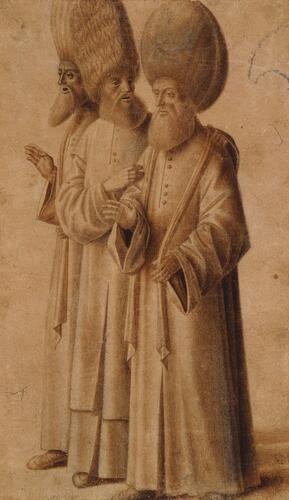Three Mamluk dignitaries c.1515-25
Brush and brown ink over black chalk, on discoloured paper | 30.4 x 17.8 cm (sheet of paper) | RCIN 990062
-
The drawing depicts three Mamluk dignitaries or merchants in conversation. The Mamluks were rulers of a large area of the Eastern Mediterranean and were trade and diplomatic partners of the Venetian Republic during its rise to supremacy (D. Howard, Venise et L’Orient, p. 73). During this period Venetian artists, particularly those in the circle of Gentile Bellini, frequently depicted Mamluk fashions and architecture in their works.
The drawing appears to be connected to a group of figures to the left of Gentile Bellini's painting of The Reception of the Venetian Ambassadors at Cairo, 1513–16 (Private collection). This painting proved hugely influential to Venetian artists at the time, and the drawing has been attributed to Giovanni di Niccolo Mansueti (Tietzes no. 801, pl. XIII, no. 2), a pupil of Gentile Bellini. Mansueti is best known for his large narrative paintings such as his cycle of the Scenes from the Life of St Mark for the Scuola Grande di S Marco (c.1518–26). Though it is unlikely that Mansueti ever visited the Eastern Mediterranean, he regularly depicted Mamluk buildings and figures in his works. The sheet is not a close copy of the figures in Bellini's painting, as the gestures and arrangement of the group have been altered. However, it is entirely possible that the figures in The Reception served as the inspiration for the present drawing, and that Mansueti made his own alterations, adapting the figures to his own design.
C. Campbell (Bellini and the East, 2006, p. 23) opined that the drawing is a conflation of individual figures from Mansueti's Arrest of St Mark (1499) and Scenes from the Life of St Mark, and thus (caption, p. 24) that the drawing is a copy after Mansueti.
The sheet of paper is discoloured from exposure to light and/or damp, and there is a restored wormhole in the headdress of the figure on the right. It is likely that the drawing was framed and displayed from an early date.Provenance
Probably Royal Collection by c.1800, but not identified in George III's Inventory A of c.1810
-
Creator(s)
-
Medium and techniques
Brush and brown ink over black chalk, on discoloured paper
Measurements
30.4 x 17.8 cm (sheet of paper)
Object type(s)









